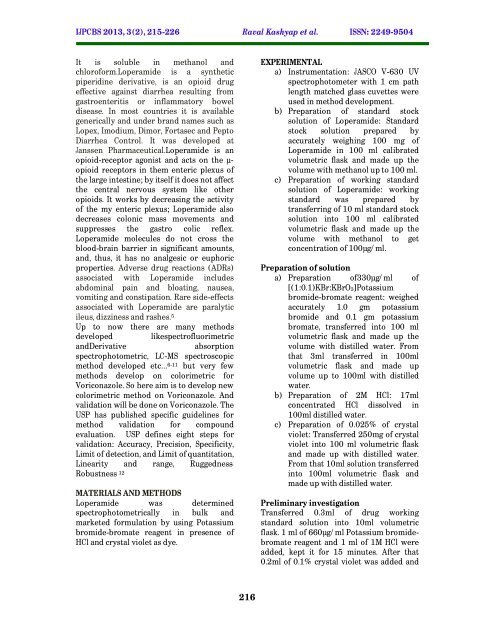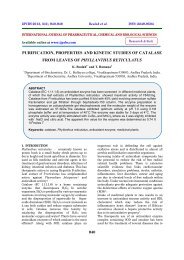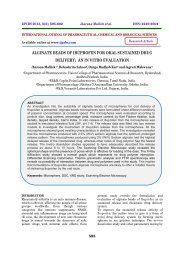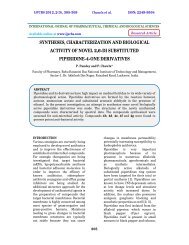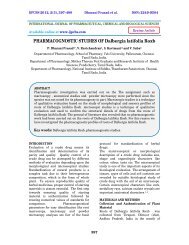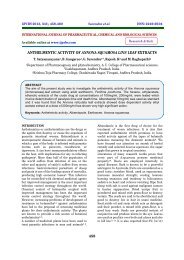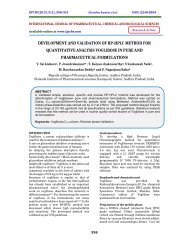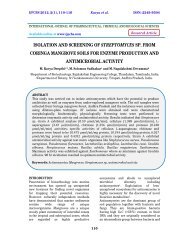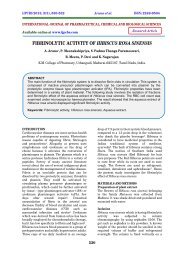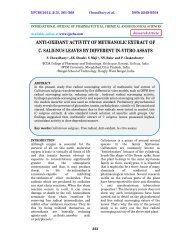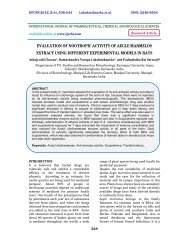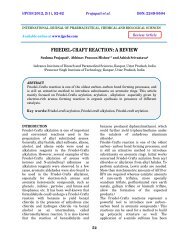development of new colorimetric method and validation for ... - ijpcbs
development of new colorimetric method and validation for ... - ijpcbs
development of new colorimetric method and validation for ... - ijpcbs
Create successful ePaper yourself
Turn your PDF publications into a flip-book with our unique Google optimized e-Paper software.
IJPCBS 2013, 3(2), 215-226 Raval Kashyap et al. ISSN: 2249-9504<br />
It is soluble in methanol <strong>and</strong><br />
chlor<strong>of</strong>orm.Loperamide is a synthetic<br />
piperidine derivative, is an opioid drug<br />
effective against diarrhea resulting from<br />
gastroenteritis or inflammatory bowel<br />
disease. In most countries it is available<br />
generically <strong>and</strong> under br<strong>and</strong> names such as<br />
Lopex, Imodium, Dimor, Fortasec <strong>and</strong> Pepto<br />
Diarrhea Control. It was developed at<br />
Janssen Pharmaceutical.Loperamide is an<br />
opioid-receptor agonist <strong>and</strong> acts on the µ-<br />
opioid receptors in them enteric plexus <strong>of</strong><br />
the large intestine; by itself it does not affect<br />
the central nervous system like other<br />
opioids. It works by decreasing the activity<br />
<strong>of</strong> the my enteric plexus; Loperamide also<br />
decreases colonic mass movements <strong>and</strong><br />
suppresses the gastro colic reflex.<br />
Loperamide molecules do not cross the<br />
blood-brain barrier in significant amounts,<br />
<strong>and</strong>, thus, it has no analgesic or euphoric<br />
properties. Adverse drug reactions (ADRs)<br />
associated with Loperamide includes<br />
abdominal pain <strong>and</strong> bloating, nausea,<br />
vomiting <strong>and</strong> constipation. Rare side-effects<br />
associated with Loperamide are paralytic<br />
ileus, dizziness <strong>and</strong> rashes. 5<br />
Up to now there are many <strong>method</strong>s<br />
developed<br />
likespectr<strong>of</strong>luorimetric<br />
<strong>and</strong>Derivative<br />
absorption<br />
spectrophotometric, LC-MS spectroscopic<br />
<strong>method</strong> developed etc… 6-11 but very few<br />
<strong>method</strong>s develop on <strong>colorimetric</strong> <strong>for</strong><br />
Voriconazole. So here aim is to develop <strong>new</strong><br />
<strong>colorimetric</strong> <strong>method</strong> on Voriconazole. And<br />
<strong>validation</strong> will be done on Voriconazole. The<br />
USP has published specific guidelines <strong>for</strong><br />
<strong>method</strong> <strong>validation</strong> <strong>for</strong> compound<br />
evaluation. USP defines eight steps <strong>for</strong><br />
<strong>validation</strong>: Accuracy, Precision, Specificity,<br />
Limit <strong>of</strong> detection, <strong>and</strong> Limit <strong>of</strong> quantitation,<br />
Linearity <strong>and</strong> range, Ruggedness ,<br />
Robustness 12<br />
MATERIALS AND METHODS<br />
Loperamide was determined<br />
spectrophotometrically in bulk <strong>and</strong><br />
marketed <strong>for</strong>mulation by using Potassium<br />
bromide-bromate reagent in presence <strong>of</strong><br />
HCl <strong>and</strong> crystal violet as dye.<br />
EXPERIMENTAL<br />
a) Instrumentation: JASCO V-630 UV<br />
spectrophotometer with 1 cm path<br />
length matched glass cuvettes were<br />
used in <strong>method</strong> <strong>development</strong>.<br />
b) Preparation <strong>of</strong> st<strong>and</strong>ard stock<br />
solution <strong>of</strong> Loperamide: St<strong>and</strong>ard<br />
stock solution prepared by<br />
accurately weighing 100 mg <strong>of</strong><br />
Loperamide in 100 ml calibrated<br />
volumetric flask <strong>and</strong> made up the<br />
volume with methanol up to 100 ml.<br />
c) Preparation <strong>of</strong> working st<strong>and</strong>ard<br />
solution <strong>of</strong> Loperamide: working<br />
st<strong>and</strong>ard was prepared by<br />
transferring <strong>of</strong> 10 ml st<strong>and</strong>ard stock<br />
solution into 100 ml calibrated<br />
volumetric flask <strong>and</strong> made up the<br />
volume with methanol to get<br />
concentration <strong>of</strong> 100µg/ml.<br />
Preparation <strong>of</strong> solution<br />
a) Preparation <strong>of</strong>330µg/ml <strong>of</strong><br />
[(1:0.1)KBr:KBrO3]Potassium<br />
bromide-bromate reagent: weighed<br />
accurately 1.0 gm potassium<br />
bromide <strong>and</strong> 0.1 gm potassium<br />
bromate, transferred into 100 ml<br />
volumetric flask <strong>and</strong> made up the<br />
volume with distilled water. From<br />
that 3ml transferred in 100ml<br />
volumetric flask <strong>and</strong> made up<br />
volume up to 100ml with distilled<br />
water.<br />
b) Preparation <strong>of</strong> 2M HCl: 17ml<br />
concentrated HCl dissolved in<br />
100ml distilled water.<br />
c) Preparation <strong>of</strong> 0.025% <strong>of</strong> crystal<br />
violet: Transferred 250mg <strong>of</strong> crystal<br />
violet into 100 ml volumetric flask<br />
<strong>and</strong> made up with distilled water.<br />
From that 10ml solution transferred<br />
into 100ml volumetric flask <strong>and</strong><br />
made up with distilled water.<br />
Preliminary investigation<br />
Transferred 0.3ml <strong>of</strong> drug working<br />
st<strong>and</strong>ard solution into 10ml volumetric<br />
flask. 1 ml <strong>of</strong> 660µg/ml Potassium bromidebromate<br />
reagent <strong>and</strong> 1 ml <strong>of</strong> 1M HCl were<br />
added, kept it <strong>for</strong> 15 minutes. After that<br />
0.2ml <strong>of</strong> 0.1% crystal violet was added <strong>and</strong><br />
216


